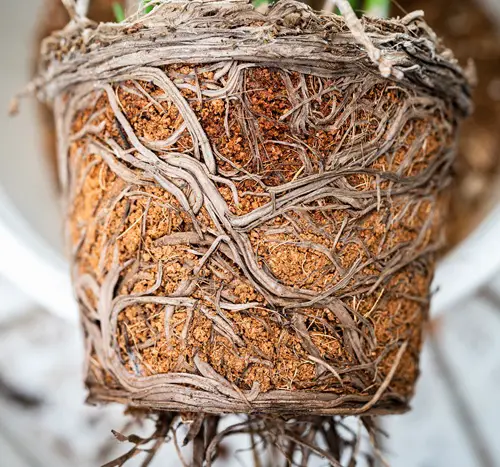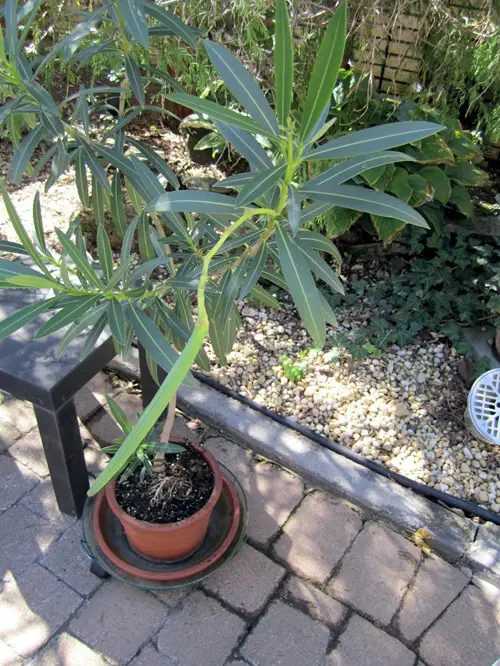Nerium plants thrive with little care and attendance, but if you want the best blooms, try these unique tricks to force your Oleander to flower crazily.
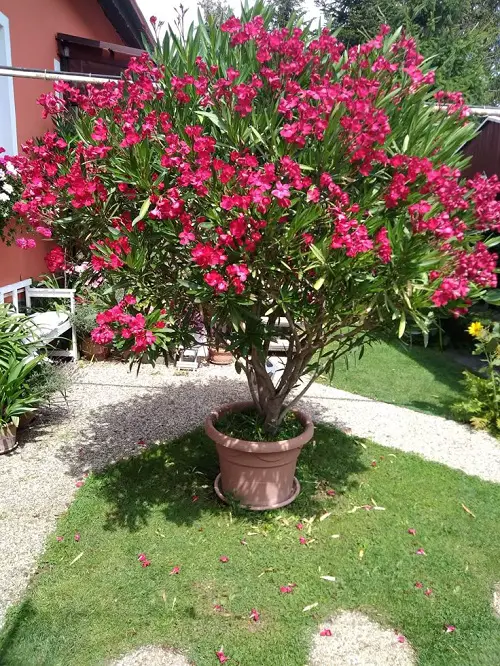
Oleander is a tough shrub that thrives in neglect and still manages to look stunning. But routine care isn’t enough if yours is playing shy and refusing to bloom. We need out-of-the-box tricks to trigger a flowering frenzy, which is what this article is all about.
Caveat: As every part of Oleander is toxic, handle it with care!
Tricks to Force Oleander To Flower Crazily
1. Keeping It In Heat
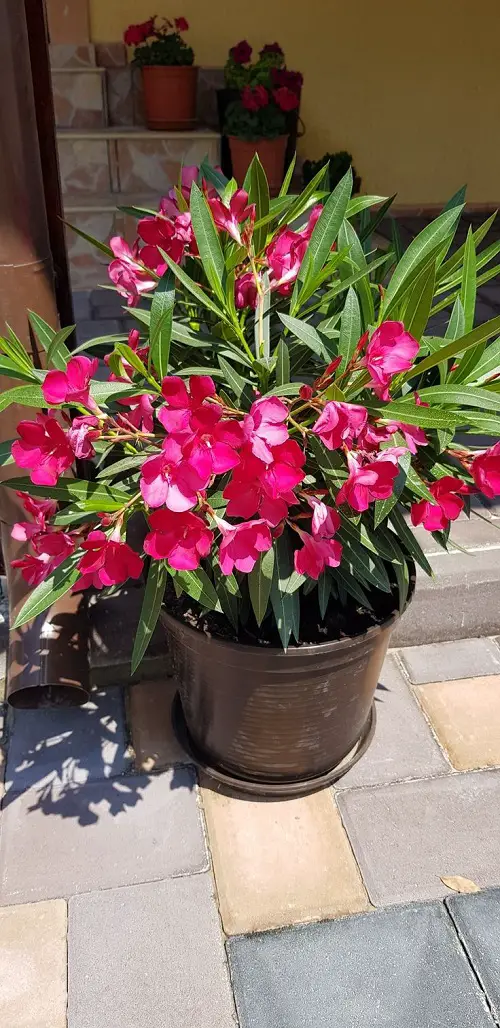
Oleander thrives in hot, arid, and Mediterranean climates, and when it suddenly experiences a temperature change, it sees this as a signal to flower before conditions get too harsh. This is a survival mechanism that plants apply because flowering ensures reproduction, so the plant responds by pushing out more blooms than usual.
As soon as early spring arrives, move your potted oleander to the warmest, sunniest spot possible. A place near a south-facing wall or against a pavement with reflected heat boosts temperature stress. It can even thrive in temperatures above 100 F (38 C), so don’t worry.
Pro Tip: If you live in a cooler region, never plant oleander in shady areas. Plus, gradually increase its sun exposure over a week or two rather than abruptly moving it into intense heat so there is no risk of scorch.
2. Strategic Root Pruning Method
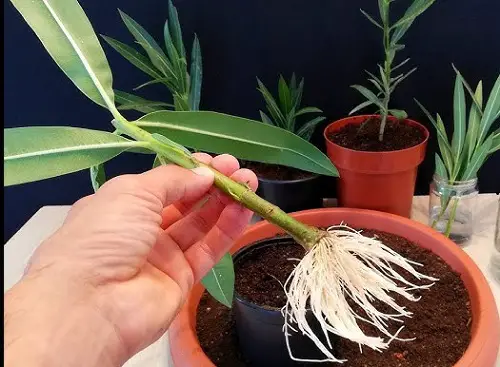
Plants hate being disturbed, and oleander is no exception. However, a light root disturbance can trick it into thinking it’s running out of resources, pushing it to put all its energy into flowering instead of growing foliage.
When growing oleander in the garden, you can use a sharp spade to slice through the roots slightly, about 12 inches from the base of the plant. This will induce a mild shock and push your plant into bloom mode.
If the roots are young and not long enough to reach 12 inches out, reduce the circle to 6–8 inches from the base—just enough to cut a few small roots without harming the plant.
If your oleander is in a pot, pull it out and trim some of the delicate roots before repotting it back into fresh soil. Doing so will stimulate new growth and increase flowering. Do not prune more than a fifth of the plant roots, though. The timing is just as crucial for root pruning, so you should do it in early spring or late winter before the plant fully wakes up.
Pro Tip: After root-pruning potted oleanders, use a well-draining potting mix and consider adding a root stimulator to encourage new root growth. Don’t root prune during the hottest parts of the year.
3. Apply Banana Peels
Bananas aren’t just a great snack! They are a secret powerhouse of potassium and phosphorus–the two nutrients directly responsible for bud and flower production.
Instead of tossing those peels into the bin, chop them up and bury them 2 inches deep in the soil around the base of your oleander. As they break down, they release flower-boosting nutrients directly into the roots.
For an extra boost, you can blend banana peels with water and pour them at the base once a week. Another way to give more boost is to add banana peel with wood ash or coffee grounds to improve potassium levels further.
Pro Tip: When using banana peels, compost them first, then use the compost as a side dressing. It will minimize the risk of attracting pests to decomposing peels.
4. DIY Epsom Salt Spray to Force Oleander Flowers

Magnesium is essential for chlorophyll production, increasing photosynthesis and energy storage, and fueling heavy bloom production. And Epsom salt (magnesium sulfate) is the easiest hack for delivering magnesium directly to Oleanders and forcing them to flower crazily.
Of course, you should use it in moderation, so here are the basics. Mix one tablespoon of Epsom salt in 3-4 liters of water and spray it on the leaves and soil monthly during the flowering season. You can find more information on this DIY here.
If your plant is potted, use half the dosage to prevent buildup in the soil. Pair this trick with banana peel fertilizer for a potent and natural bloom-boosting combo!
Pro Tip: This trick works best in spring and summer; applying it too late may not produce significant results.
5. Keeping It Slightly Root Bound
Believe it or not, Oleanders actually love a bit of stress, and being root-bound is the kind of stress they thrive under when it comes to flowering.
When roots have limited space, the plant shifts focus from growing more leaves and stems to producing blooms. This is a survival response—with less room to expand underground, your plant gets the message that it’s time to reproduce!
To use this trick, grow your oleander in a container that’s just slightly smaller than what you’d typically choose. Don’t go overboard—a pot that’s about 1-2 inches bigger than the root ball is enough.
Pro Tip: Use a terracotta pot instead of plastic, as these are breathable and encourage better root health, even in tight quarters.
6. Go With a Poor, Well-Draining Soil
Oleander hails from Mediterranean regions where the soil is anything but rich and fluffy. It prefers gritty, poor, even slightly rocky soil that drains fast and stays dry between waterings, just like the Rosemary.
Rich, moisture-retentive soil often leads to lush, leafy growth but few flowers.
So, giving a leaner medium will trigger the plant to focus on reproduction, which equals more blooms. We suggest that you skip the compost-heavy potting mixes. Instead, create a custom mix using coarse sand, perlite, and some regular garden soil with a handful of crushed gravel. Then, you can add a handful of compost in it, but never too much.
Pro Tip: If water sits in the pot or ground after you water, that soil is too heavy. You need to add more sand, perlite, or gravel.
The goal is to avoid moisture buildup and mimic its native arid environment. If you’re growing oleander on the ground, amend your soil with gravel and sand if it’s too loamy or clay-heavy.
7. Grow it in Full Sun
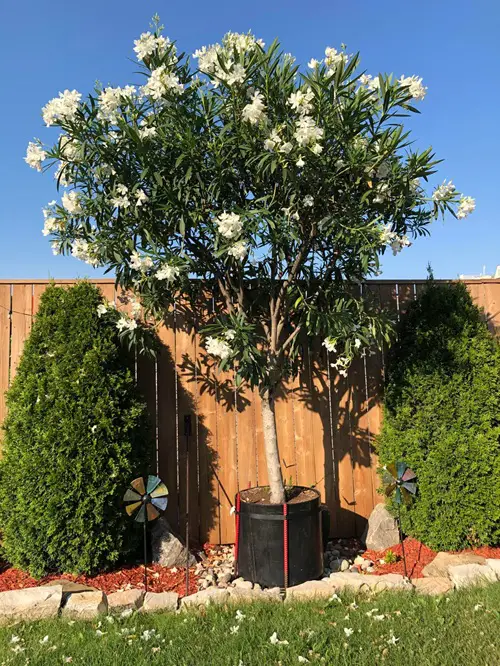
Now, let’s be clear—oleander absolutely needs full sun to bloom well, so instead of a trick, you should call it a baseline requirement. Although sunlight encourages bud formation, it doesn’t shock or push the plant into blooming the way root stress or lean soil does, but it is the best you can do for flowering.
That being said, inadequate sunlight will prevent blooming entirely, so this tip still deserves a place in your care guide.
For best blooming results, oleander needs at least 8 hours of direct sunlight daily. Place it in the sunniest spot in your garden or balcony where it gets more intense afternoon sun.
Shaded or partially shaded locations will lead to leggy growth and zero flowers. You can also rotate your potted oleander every few weeks to ensure even exposure and bushier growth.
Well, what are you waiting for? Time to put these tricks to force Oleander to flower to work! And don’t forget to keep it away from your pets and children; it’s toxic!


